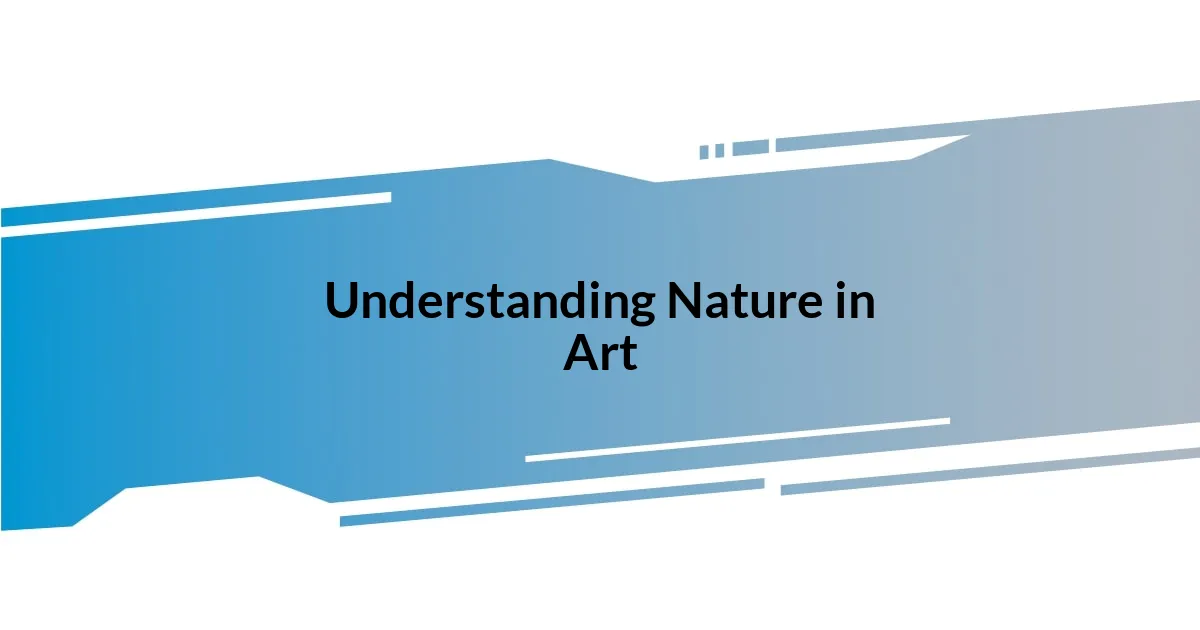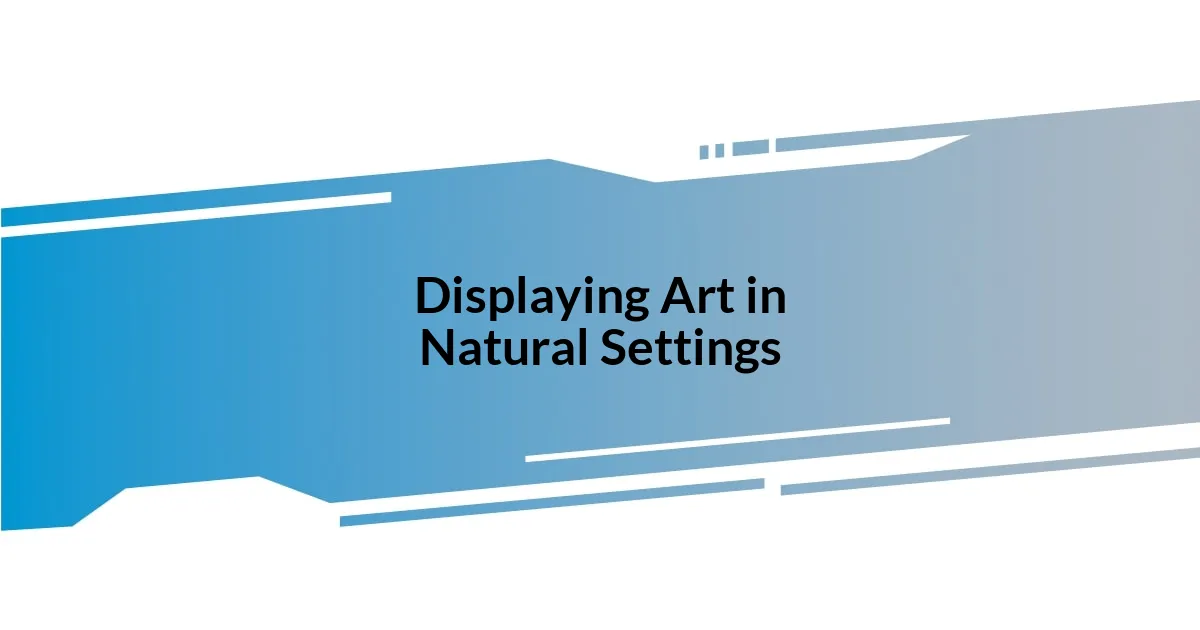Key takeaways:
- Nature serves as a profound source of inspiration, encouraging artists to connect emotionally with their work and viewers.
- Choosing natural materials enhances sculptures by adding unique essences and stories, highlighting beauty in imperfections.
- Techniques such as using organic forms and textures help create pieces that resonate with the rhythms and emotions of nature.
- Creating sustainable art using reclaimed materials fosters a connection between artistic expression and environmental values.

Understanding Nature in Art
Nature has always been a profound source of inspiration for artists, including myself. I often find myself wandering through parks or forests, absorbing the intricate details of leaves or the patterns formed by tree bark. Isn’t it fascinating how a simple stroll can evoke such a deep appreciation for the natural world?
One particular moment that stands out to me was when I came across a patch of wildflowers during a hike. The vibrant colors and delicate shapes sparked an idea for a new sculpture. How can we, as artists, translate the beauty of these fleeting moments into our work? That question often lingers in my mind and shapes my creative process.
Incorporating nature into art isn’t just about representation; it’s about connecting with the viewer on an emotional level. When I sculpt, I strive to evoke the feelings I experience in nature—joy, peace, sometimes even solitude. This connection can resonate with anyone who has spent time in the wild, reminding them of their own experiences and feelings toward our environment.

Choosing Natural Materials
Choosing natural materials is a pivotal step in my creative journey. I have found that each type of material brings its unique essence and story to a sculpture. For instance, working with driftwood not only connects my pieces to the river’s journey but also evokes a sense of tranquility. The rugged texture and organic shape of pieces I’ve collected from the shore often remind me of spontaneous moments by the water, infusing a piece with a sense of history.
Another fascinating aspect of selecting natural materials is the delightful surprise of finding beauty in imperfections. When I stumbled upon a weathered stone during a hike, I couldn’t help but feel a connection. The cracks and irregularities told a story of resilience against the elements. These little imperfections inspire me to incorporate them into my work, revealing a deeper narrative within my sculptures that can resonate with viewers on a very personal level.
Moreover, sourcing these materials often adds to my artistic process—whether it’s the vibrant colors from colored clays or the unique grain patterns in wood. I remember a time when I visited a local quarry, stumbling across a vibrant piece of stone that felt alive. Choosing the right natural materials becomes not just a practical decision, but an artistic exploration of texture, color, and history that fuels the very spirit of my sculptures.
| Natural Material | Emotion/Connection |
|---|---|
| Driftwood | Tranquility, history of the river |
| Weathered Stone | Resilience, connection to nature |
| Colored Clays | Vibrancy and earthiness |
| Wood | Warmth, unique grain patterns |

Techniques for Using Organic Forms
When it comes to using organic forms in my sculptures, I often rely on the natural shapes I encounter in my surroundings. I’ve found that observing the curves of a vine or the silhouette of a mountain can ignite my imagination. This connection to natural contours allows me to create pieces that feel alive, almost as if they could breathe.
- Study the natural world: Spend time observing forms in nature—trees, flowers, and landscapes.
- Use molds: I sometimes cast the shapes of leaves or flowers in resin to replicate their delicate beauty.
- Experiment with assemblage: Combine various organic materials, like shells or twigs, to create multi-layered structures that tell a story.
- Follow the flow: Allow the shape of your material to lead the design; embrace the way it wants to grow.
In a recent project, I took a handful of twisted branches from my backyard. They showcased the raw beauty of nature’s design, with each curve telling a story. As I arranged them, I could feel my own emotions weaving into the sculpture. It became more than just an art piece; it resonated with my experiences of untamed landscapes and the serenity they provide. Ultimately, embracing organic forms invites an authenticity into my work that feels almost magical.

Inspiration from Natural Landscapes
Natural landscapes have a profound influence on my sculptures. When I hike through a vibrant forest or stand atop a rugged cliff, I often find myself captivated by the play of light and shadow. I remember one particular evening watching the sun dip below the horizon, casting golden hues across a valley. That moment inspired a series of works where I aimed to replicate that ephemeral beauty through textures and colors that evoke the warmth and serenity of nature.
I often take long walks to replenish my creative energy, allowing the environment to speak to me. One day, while wandering through a meadow, I found myself mesmerized by the wind dancing through the tall grass. This experience compelled me to create fluid forms in my sculptures that mimic that movement. Isn’t it fascinating how nature’s rhythm can inspire our own creativity? It’s as if every rustling leaf and shifting stone is sharing a story that I can translate into my art.
Visiting varied landscapes enriches my perspective and feeds my imagination. For example, during a trip to a sandy beach, the shifting dunes inspired me to explore the idea of impermanence in my work. I began to incorporate not just the shapes I observed but also the emotions these landscapes stirred within me. Through these experiences, I’ve learned that the connection to natural forms isn’t just visual—it’s deeply emotional, transforming my sculptures into a dialogue between nature and my artistic journey.

Incorporating Textures and Colors
When I think about textures and colors, I often reflect on my time by the ocean. I remember collecting sea glass and smooth pebbles, each piece adorned with colors shaped by the relentless waves. These natural hues—blues, greens, and frosty whites—have found their way into my sculptures. It amazes me how a simple beach walk can spark the imagination, leading to a vibrant palette that breathes life into my creations.
I enjoy experimenting with different materials to capture the tactile qualities of nature. One of my favorite techniques is using a palette knife to create rough, organic textures that mimic the rugged surfaces of tree bark or windswept sand. As I work, I connect emotionally with every scrape and layer, feeling as though I’m channeling the essence of the landscape. It’s like placing a piece of my soul into each work. Have you ever felt that connection while creating?
In my recent project, I decided to incorporate colors inspired by sunsets I’ve witnessed in my travels. By mixing warm oranges and deep purples with textured layers, I aimed to encapsulate the fleeting beauty of those moments. I truly believe that color can evoke emotion. When I step back and gaze at the finished piece, I can’t help but feel a rush of nostalgia. It’s in these elements—the textures and colors—that my art transcends mere visuals; it becomes a dialogue with both the viewer and the natural world.

Creating Sustainable Sculptures
Creating sustainable sculptures is a journey that aligns my artistic vision with my environmental values. I particularly enjoy using reclaimed materials, like driftwood or scrap metal, which not only reduce waste but also add a unique story to each piece. One day, while sifting through a local scrap yard, I stumbled upon an old bicycle frame, and I couldn’t help but envision it transformed into a striking peacock. The idea of breathing new life into something discarded is both exhilarating and fulfilling. Isn’t it inspiring to think how art can rise from what others deem waste?
I also prioritize eco-friendly processes in my work. Instead of relying solely on synthetic materials, I experiment with biodegradable substances like clay and natural pigments. I recall an afternoon spent gathering clay beneath a babbling brook, surprised at how grounding that experience felt. Returning to my studio, I shaped the clay into sculptures that not only reflect nature but also honor it. This connection between creation and conservation enriches my practice, doesn’t it? Each artwork becomes a part of a larger conversation about sustainability.
Moreover, I’ve found that creating outdoor installations can amplify the impact of sustainable art. One summer, I collaborated with local environmentalists to set up an exhibit in a nature reserve. The sculptures, composed of natural materials and positioned among the trees and flowers, embodied the spirit of the surroundings. I felt a sense of unity, almost as if the sculptures were extensions of the landscape itself. Have you ever thought about how art can interact with its environment? This experience reminded me that sustainability isn’t just a choice but a philosophy that shapes how we engage with the world through our art.

Displaying Art in Natural Settings
Displaying art in natural settings elevates the viewer’s experience and fosters a deeper connection with both the artwork and the environment. I recall a moment when I installed one of my sculptures in a serene forest clearing. As I stepped back to observe, the dappled sunlight streaming through the leaves added a dynamic quality to my piece. It dawned on me how the interplay of light and shadow created an ever-changing visual dialogue, amplifying the sculpture’s presence and inviting onlookers to explore both art and nature.
I also enjoy choosing locations that resonate with the themes of my work. For instance, I once placed a sculpture inspired by flowing water near a gentle stream. As the water babbled nearby, I noticed how the sound enhanced the sculpture’s narrative. Isn’t it fascinating how the natural sounds can influence the emotional tone of an artwork? This harmony between art and its setting not only breathes life into the sculptures but also encourages viewers to pause, reflect, and interact on a more personal level.
Additionally, I find that allowing nature to influence the display can create beautiful spontaneity in the experience. The way a sculpture interacts with the elements—like how wind can sway a mobile I created or how rain can wash away layers of paint—reminds me of the impermanence of both art and life. I sometimes wonder, do we not see our creations in a purer form when they’re allowed to evolve? Embracing this organic relationship not only enriches my artistic practice but also invites viewers into an ongoing dialogue about nature’s power and resilience.